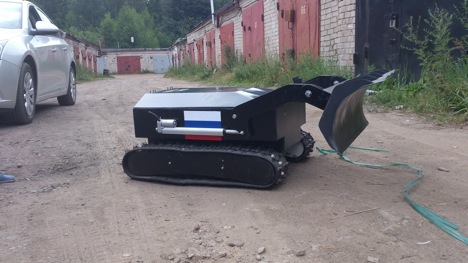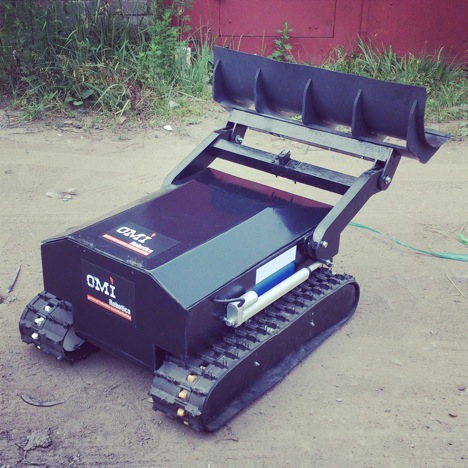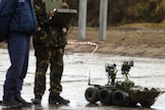Snowplough robot to come to the rescue this winter

The OMI-Plowv snowplough robot. Source: Press Photo
The idea for a snowplough robot came to Oleg Kivokurtsev, a postgraduate student at the Perm Polytechnical University. “We were repulsed by unofficial statistics, which stated that 838 people sought medical assistance at first aid stations in Moscow on the first day of a heavy snowfall,” explains the founder of the start-up company. “The streets are rarely cleared of snow more than twice a day – and that is not sufficient during a heavy snowfall,” he says. Kivokurtsev founded OMI-Robotics and developed the robot concept, which was christened the OMI-Plowv.
The entrepreneur developed the first prototype of this system with his friends, designer Igor Yeremeyev and engineer Maksim Uteyev in March 2013. “This really was a garage innovation,” recalls Igor Uteyev “The robot was put together using parts of a sawn up wardrobe, while the internal workings were formed of motors from an electric window system. Not to mention the frame, which we painted in a standard black colour from a stain-repellent.”
The developers understood however that this makeshift prototype would need to be modified. They reached agreement on free assembly of this robot on one of the production lines at the Krasnokamsk repair and maintenance plant. In the new version, which was produced in May OMI-Plowv had been transferred onto more powerful caterpillar tracks and was fitted with batteries. These allowed the robot to operate for 8 hours after a 6-hour charge from an electric socket.

Source: Press Photo
OMI-Plowv can pile up snow in a specifically designated location with the help of a bucket, clearing around 30 square metres in the space of 5 minutes. The maximum depth of snow that the 60-cm tall robot can cope with is no more than 10 cm. OMI-Plowv also sends the homeowner a text warning of low battery and lets them know when the snow has been cleared. Moreover the system works in two modes: the robot can be controlled manually with the help of a joystick or a keyboard via Wi-Fi or the robot can be taken along the route once to familiarise itself with the main areas where snow needs to be cleared. A programme installed on a computer can receive images taken from a video camera on board the robot, and the computer can feed the system signals to control the caterpillar tracks and the shovel. In this case the programme built into the robot counts the number of turns of the wheels controlling the caterpillar tracks and this allows the system to memorise the route.
By this winter the founders of the start-up company have promised to install an intelligent control system in OMI-Plowv and also to teach the robot to decide for itself whether an area needs to be cleared of snow or not. The system will be fitted with meteorological sensors to measure temperature, and the depth and consistency of snow.

Source: Press Photo
The system costs around 75,000 to 90,000 roubles to buy ($2,277 to $2,732). The American mini-bulldozer Roboplow is a counterpart of the Russian invention, and is also fitted with a shovel and can be controlled via a computer but has a more limited ability to penetrate so far since it is on wheels, and costs more than $9,700 plus delivery charges.
OMI-Robotics is planning to sell the system via a dealership network, which would incorporate companies already working in the robotics market. The start-up’s first client was a citizen of the Czech Republic, who saw the videos about the Russian robot on You Tube. After receiving the system the client contacted Kivokurtsev again and requested that he fit the robot with a manipulating arm to pick up rubbish. It was then that the entrepreneurs decided to produce a universal platform based on OMI-Plowv, onto which different accessories could be fitted. Each new option costs the client around $911 to $1,518.
Source: Igor Yeremeev / YouTube
Today OMI-Robotics has preliminary agreements with 30 potential dealers. In parallel with this the start-up company is taking pre-orders via an internet-shop on their own site. The start-up is hoping to be able to sell a pilot batch of 75 robots to suburban and weekend homeowners in December. By next winter OMI-Robotics is planning to expand its customer base, offering its invention to municipal services and owners of business premises.
The founders have spent around $15,185 developing the system, some of which the company received in the form of grants for winning several regional competitions. In order to launch series production however and to promote their product on the Internet the company requires at least a further $46,000 of investment. In September 2013, the company was given the highest rating for its investor’s attractiveness within the confines of the Russian Startup Rating (AAA).
Oleg Baskov, the General Director of the Zelenogradsk centre for the transfer of technologies thinks that “up until now the team has demonstrated a large remote controlled toy. However an intelligent control system is required with navigation and artificial vision in order for a robot to truly operate independently, and this is a task on another level of complexity. Hundreds of millions of dollars and decades of work have been invested in this technology so the start-up company have a long road ahead of them to understand this challenge and to solve it.”
Read the full version in Russian.
All rights reserved by Rossiyskaya Gazeta.
Subscribe
to our newsletter!
Get the week's best stories straight to your inbox

